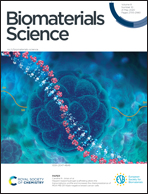A bioartificial liver support system integrated with a DLM/GelMA-based bioengineered whole liver for prevention of hepatic encephalopathy via enhanced ammonia reduction
Abstract
Although bioartificial liver support systems (BLSSs) play an essential role in maintaining partial liver functions and detoxification for liver failure patients, hepatocytes are unanimously seeded in biomaterials, which lack the hierarchal structures and mechanical cues of native liver tissues. To address this challenge, we developed a new BLSS by combining a decellularized liver matrix (DLM)/GelMA-based bioengineered whole liver and a perfusion-based, oxygenated bioreactor. The novel bioengineered whole liver was fabricated by integrating photocrosslinkable gelatin (GelMA) and hepatocytes into a DLM. The combination of GelMA and the DLM not only provided a biomimetic extracellular microenvironment (ECM) for enhanced cell immobilization and growth with elevated hepatic functions (e.g., albumin secretion and CYP activities), but also provided biomechanical support to maintain the native structure of the liver. In addition, the perfusion-based, oxygenated bioreactor helped deliver oxygen to the interior tissues of the bioengineered liver, which was of importance for long-term culture. Most importantly, this new bioengineered whole liver decreased ammonia concentration by 45%, whereas direct seeding of hepatocytes in a naked DLM showed no significant reduction. Thus, the developed BLSS integrated with the DLM/GelMA-based bioengineered whole liver can potentially help elevate liver functions and prevent HE in liver failure patients while waiting for liver transplantation.



 Please wait while we load your content...
Please wait while we load your content...